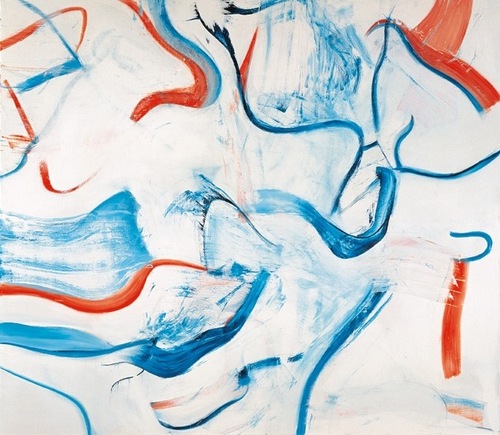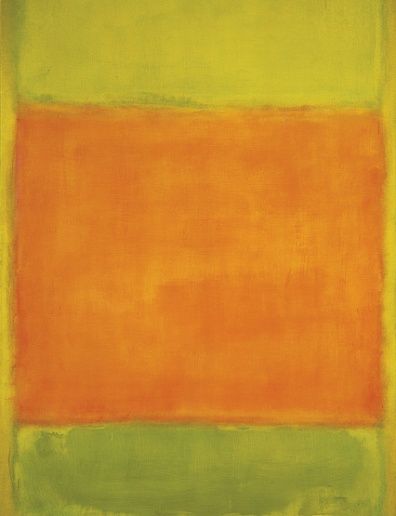Referred by my friend Sam Masters, pastor and painter in Argentina.
by Matthew Raley One of the visual abstractions we noticed in Alfred Hitchcock's Vertigo was his evocation of famous paintings. We saw that his shot of Madeleine floating in the Bay alludes to the painting of Ophelia by Millais, and that references like this give an unconscious emotional atmosphere to the film.
Bernard Herrmann uses a similar abstraction in Vertigo's score. He refers to musical forms in a way that intensifies the cultural and psychological atmosphere. Two such references are important to the score's role as co-narrator with the camera.
First, Herrmann employs a habanera rhythm in relation to Carlotta. The habanera was a Cuban dance that made its way to Spain in the 19th century, and thence to Europe, becoming famous through Georges Bizet’s Carmen. As a cultural artifact, the dance is associated not just with Hispanic atmosphere but also with seduction.
https://www.youtube.com/watch?v=lspRhX5Vhhg&feature=fvsr
Second, Herrmann uses ecclesiastical forms in his cues at Mission Dolores. He draws the church modes into his harmonies, employing sighing motifs, and using a pipe organ.
Both references, which David Cooper calls “extraopus intertextuality,”[1] remain at some distance from their antecedents. They are not literal. No one dances a real habanera during a café floor show. Scottie doesn’t pass an organist on his way to the graveyard. By remaining abstract, these references allow one’s imagination to play at a less conscious level, and with profoundly ironic implications.
[1] David Cooper, Bernard Herrmann’s Vertigo: A Film Score Handbook, Film Score Guides (Westport CT: Greenwood Press, 2001), 65.
by Matthew Raley
 I've given several examples of Alfred Hitchcock's abstract visuals in Vertigo (here and here). But Hitchcock also created a sound-world to match, and he found a collaborator in Bernard Herrmann. Together, they raised the score to the level of co-narrator with the camera.
I've given several examples of Alfred Hitchcock's abstract visuals in Vertigo (here and here). But Hitchcock also created a sound-world to match, and he found a collaborator in Bernard Herrmann. Together, they raised the score to the level of co-narrator with the camera.
The term “Wagnerian” is often used to characterize Herrmann’s score for Vertigo, and for good reason. But the variety of composers who influenced Herrmann hints at a more complex musical imagination.
He was famous for loving English composers such as Edward Elgar[1] and Ralph Vaughan Williams.[2] Vertigo’s frequent similarity to music by Claude Debussy is mentioned by critics.[3] Less well-known is Herrmann’s study as a thirteen-year-old of Hector Berlioz’s Treatise on Orchestration. The influence this Romantic maverick had on Herrmann was life-long.[4] Nor was Berlioz the only musical outsider with whom Herrmann identified. Though Herrmann spent his student years in New York close to such American icons as Aaron Copland and George Gershwin, Herrmann also developed relationships with young radical composers in a group modeled on Les Six.
Most significantly, Steven Smith documents Herrmann’s long association with Charles Ives, the ultimate outsider, noting Herrmann’s early study of Ives’s 114 Songs and his habitual visits with Ives until Ives died in 1954.[5]
With such a background, there should be no surprise that Herrmann’s score is one of the more abstract elements of Vertigo.
It is not explicitly tonal—that is, the harmonies are not organized around a triad that specifies a key, but around the pitch-class structures and intervallic relationships that occur in the first bars of the prelude. Such harmonies, while not expressionistic, are at the outer reaches of the common practice era.
Herrmann, further, employs a modular phrase structure that permits the extension of a line, but is not intrinsically melodic, alluding to but not identical with the traditional eight- or sixteen-bar phrase.

As we will explore over the next posts, the abstraction of Vertigo’s music allows it to operate with subtlety, concision, and force. The score is a large part of the greatness of this film.
[1]Bernard Herrmann, “Elgar: A Constant Source of Joy,” in Edward Johnson, Bernard Herrmann: Hollywood’s Music-Dramatist, Bibliographical Series 6 (Rickmansworth: Triad Press, 1977), 29–31.
[2]Bernard Herrmann, “Vaughan Williams’s London Symphony,” The Musical Times 100, no. 1391 (1959): 24.
[3]William H. Rosar, “Bernard Herrmann: The Beethoven of Film Music?,” The Journal of Film Music 1, no. 2 (2003): 137; Royal S. Brown, “Herrmann, Hitchcock, and the Music of the Irrational,” Cinema Journal 21, no. 2 (April 1, 1982): 20.
[4]Steven C. Smith, A Heart at Fire’s Center: The Life and Music of Bernard Herrmann (Berkeley: University of California Press, 2002), 14–15.
[5]Ibid., 21–23, 38–39.
by Matthew Raley Abstraction in art is any step away from a thing-in-itself. Artists use abstraction to open emotional and reflective space in their work -- space that isn't there at the literal level. As I wrote in my last post, there is a range of abstraction levels in every work of art, and Hitchcock's Vertigo is especially full of examples.
I've shown several examples of how Hitchcock took steps away from concrete referents like characters inside the film and even artworks outside of it. Here are some instances of higher visual abstraction, in which the referents are less concrete.

A quite high level of abstraction is the reference of the film back upon itself. This is not merely the foreshadowing of an event early and the event’s later completion, but the recurrence of entire sequences of action, like the pursuits that end with Scottie witnessing a fatal plunge. Deborah Linderman, for example, acknowledging her dependence on Raymond Bellour, reads Vertigo as “a series of self-reflecting mirrors,” describing a displacement of stasis that recurs all the way to the final shot.[1] Peter Wollen uses similar terms to describe the plot.[2]
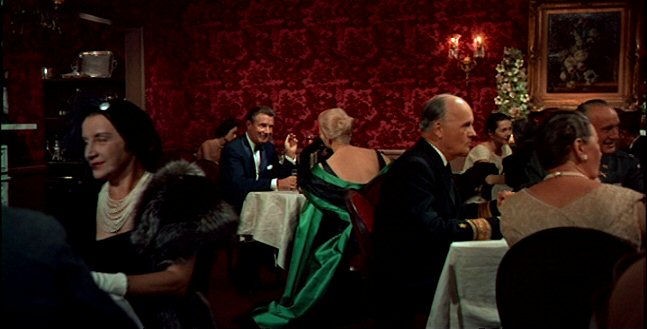
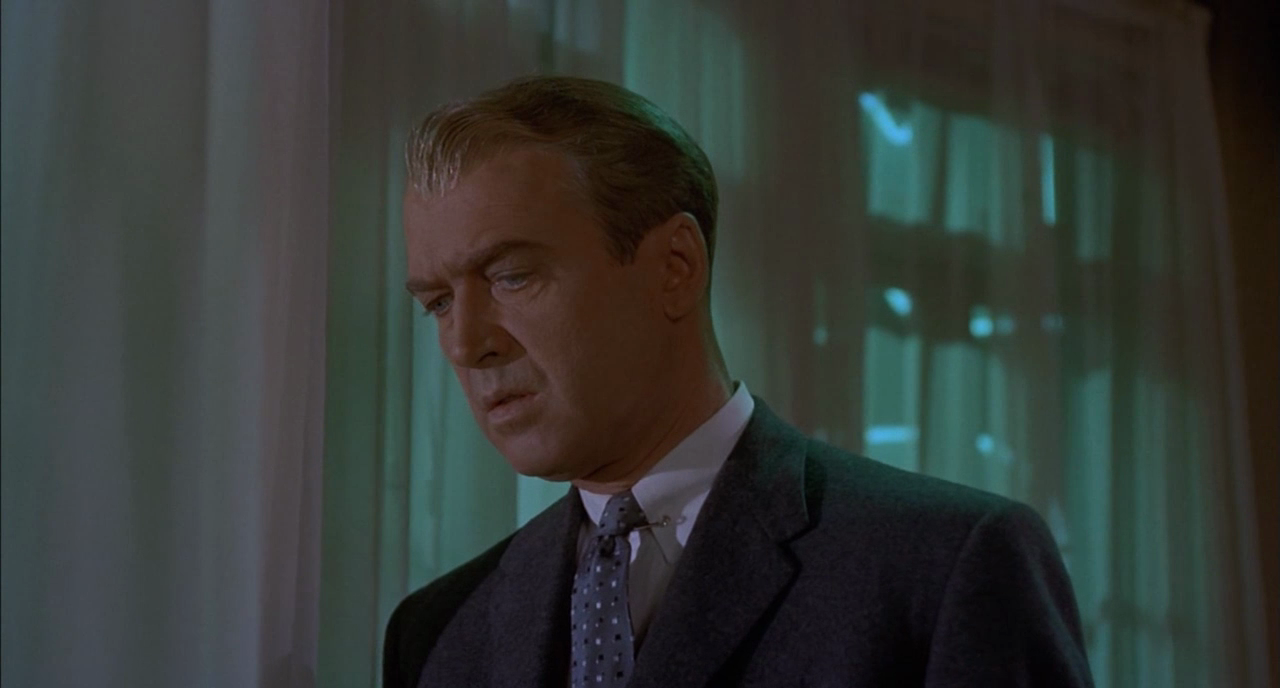 The motif of red and green that permeates the film does not represent a literal thing in the story; the colors influence the emotional atmosphere while maintaining visual coherence. The drab greens and reds in the hallway leading to Judy’s hotel room can be seedy, while the red and green theme at Ernie’s can communicate opulence. The artificially limited palette retains a broad range of impacts.
The motif of red and green that permeates the film does not represent a literal thing in the story; the colors influence the emotional atmosphere while maintaining visual coherence. The drab greens and reds in the hallway leading to Judy’s hotel room can be seedy, while the red and green theme at Ernie’s can communicate opulence. The artificially limited palette retains a broad range of impacts.
 Another example of this level of abstraction would be the famous spiral motif in the opening titles. Spiral references occur in Scottie’s nightmare, in the mission tower staircase, and even in Madeleine’s hair. While the spiral does represent the physical condition of vertigo, in a sense, there is no suggestion that the condition actually looks like a spiral, either to the onlooker or to the sufferer. On the contrary, the literal imitation of vertigo is Hitchcock’s famous point-of-view shot in which the camera zooms in and tracks back at the same time.
Another example of this level of abstraction would be the famous spiral motif in the opening titles. Spiral references occur in Scottie’s nightmare, in the mission tower staircase, and even in Madeleine’s hair. While the spiral does represent the physical condition of vertigo, in a sense, there is no suggestion that the condition actually looks like a spiral, either to the onlooker or to the sufferer. On the contrary, the literal imitation of vertigo is Hitchcock’s famous point-of-view shot in which the camera zooms in and tracks back at the same time.
Again, each level of reference raises the significance of the story’s literal elements, enabling us to reflect on the story, explore the internal structure, and discover larger meanings. The film is not just about a dizzy cop. The spiral helps us connect vertigo with erotic obsession. The mise-en-scène prompts us to question the characters’ relationships and motives more deeply. A simple filter can lift an image out of the prosaic and invite a second look, a thinking look.
[1]Deborah Linderman, “The Mise-en-Abîme in Hitchcock’s ‘Vertigo’,” Cinema Journal 30, no. 4 (July 1, 1991): 52.
[2]Peter Wollen, “Compulsion - Does Vertigo, Hitchcock’s Most Personal and Perverse Thriller, Show Him as a Surrealist?,” Sight and Sound. 7, no. 4 (1997): 14.
by Matthew Raley To start exploring why Vertigo has been called one of the greatest films of all time, let's look at Alfred Hitchcock's use of abstraction. The word abstract is used freely to describe artworks, but the meaning of the word can be difficult to specify.
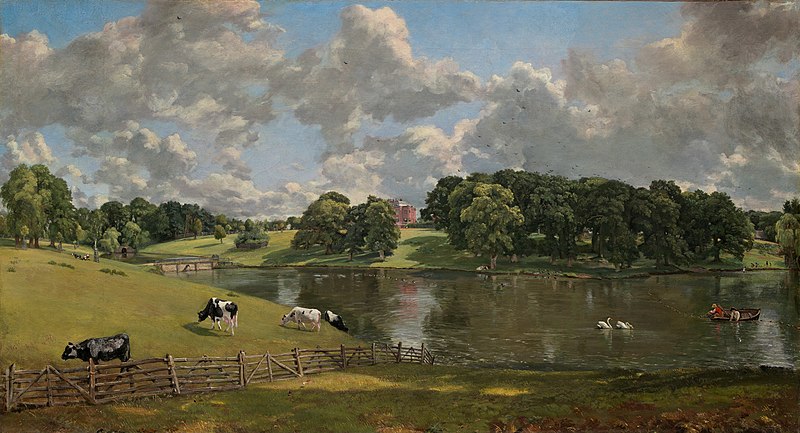

Abstraction in art is usually contrasted with representation, the use of forms rather than the use of imitation, as if these were absolute categories. This antithesis is easy enough to maintain if the artworks are Piet Mondrian’s Composition II in Red, Blue, and Yellow (1930) and John Constable’s Wivenhoe Park (1816). But I wonder whether antithesis is the best way to analyze abstraction in a work. Is there no abstraction in a painting if it contains recognizable eyes, ears, or fingers?
Clearly not. Artworks have many levels of abstraction in them, from low to high.
I define abstraction as any step away from a referent, from things-in-themselves to representations, imitations, or evocations of those things. An artist may intend such a reference to be close or distant, obvious or subtle, and the artist uses this range of interaction with things to control a work’s atmosphere, meaning, and relationship to its audience.
Hitchcock is a master at employing many levels of visual abstraction, and Vertigo is filled with examples.
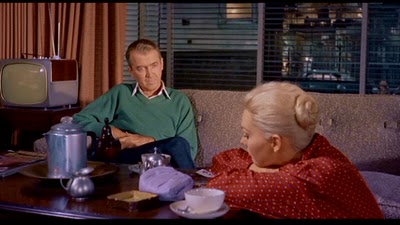
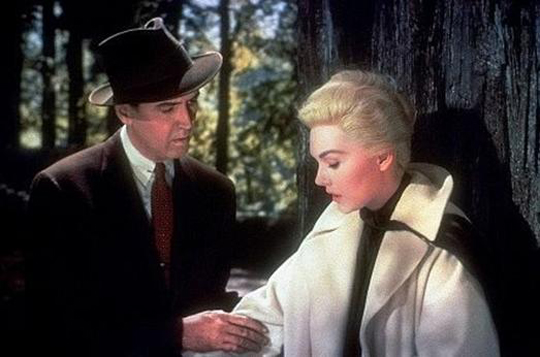
Take two low levels of abstraction. The first, so low as to be routine, would be the camera’s literal capture of James Stewart and Kim Novak not representing themselves but Scottie and Madeleine. A slightly higher level would be the representation of Stewart and Novak in the Redwoods using a filter, which lends a dream-like quality that is less representational of the literal scene.
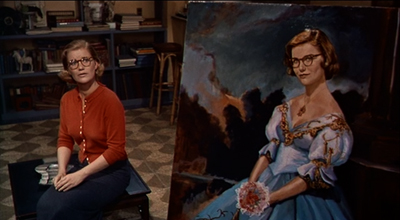
Hitchcock’s layered mise-en-scène throughout Vertigo would be a higher level of abstraction yet, informing plot development and characterization through placement within the frame. The point of view shot in which Scottie sees Midge’s parody of the Carlotta portrait next to Midge herself in the same pose is only one instance, a double juxtaposition of the fantastic with the normal.


Mise-en-scène, in a still higher level of abstraction, can refer to iconic images from other art sources. One critic, for example, argues that Hitchcock’s portrayal of Madeleine in the bay refers to the Pre-Raphaelite Ophelia (1852) by John Everett Millais.[1]
So a reason for Vertigo's greatness is the richness of Hitchcock's visual language. He crafts frames with varying degrees of abstraction, creating an emotional resonance with the viewer.
We'll see more examples of this next week.
[1]James M. Vest, “Reflections of Ophelia (And of ‘Hamlet’) in Alfred Hitchcock’s ‘Vertigo’,” The Journal of the Midwest Modern Language Association 22, no. 1 (April 1, 1989): 1-9.

